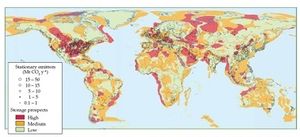Trapping and Transporting Carbon Dioxide
Trapping and Transporting Carbon Dioxide
| Topics: |
Proximity to energy consumers and fuel sources largely determines the placement of new electric power plants. Only some of these facilities are located in areas with ready access to geological formations or deep waters that might provide long-term CO2 storage. Widespread adoption of CO2 capture and storage therefore hinges on the ability to transport CO2 from where it is produced to where it will be stored.
Several chemical properties of CO2 influence its transport.
• CO2, if kept dry, is noncorrosive and compatible with pipes and storage vessels made of regular steel. In the presence of water, CO2 forms carbonic acid, which is corrosive and must be contained in resistant alloys that are several times more expensive than regular steel.
• At standard temperature and pressure (0°C, 0.1 MPa), CO2 is a colorless, odorless gas that is heavier than air. (CO2 has a density of 1.98 kg m–3; air has a density of 1.229 kg m–3.) Thus, CO2 that leaks out during transport tends to accumulate in depressions and may endanger people if its concentration exceeds 22%.
• Liquid CO2 has a density of 929 kg m–3 at 0°C and 3.5 MPa, and so moving CO2 as a liquid transports 500 times more CO2 per unit volume than as a gas. Most systems, therefore, transport liquid CO2 despite the high pressures, low temperatures, and extra energy required for maintaining CO2 in this state. Unfortunately, the high pressures and low temperatures of the liquid make it more dangerous than the gas.
Given the risks from leaks, facilities for CO2 transport should be located as far as possible from densely populated areas.
Two major modes of CO2 transport are pipelines and tanker ships. Pipelines operate at ambient temperatures and high pressures (10 MPa to 80 MPa), conditions under which CO2 becomes a supercritical fluid, and so its density varies continuously with pressure without a distinct phase change. Tanker ships are more economical than pipelines for CO2 transport over long distances. Ships carry liquefied CO2 at low temperatures (approximately -50°C) and several atmospheres pressure (approximately 0.7 MPa), using technology similar to that for transport of liquefied natural gas (LNG). Perhaps in the future, ships will transport LNG from gas fields to power plants and return with loads of liquefied CO2 for injection into the gas wells for long-term storage.
This is an excerpt from the book Global Climate Change: Convergence of Disciplines by Dr. Arnold J. Bloom and taken from UCVerse of the University of California.
©2010 Sinauer Associates and UC Regents

0 Comments